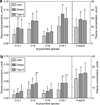Increased levels of plasma acylcarnitines in obesity and type 2 diabetes and identification of a marker of glucolipotoxicity
- PMID: 20111019
- PMCID: PMC3984458
- DOI: 10.1038/oby.2009.510
Increased levels of plasma acylcarnitines in obesity and type 2 diabetes and identification of a marker of glucolipotoxicity
Abstract
Dysregulation of fatty acid oxidation (FAO) is recognized as important in the pathophysiology of obesity and insulin resistance (IR). However, demonstrating FAO defects in vivo in humans has entailed complex and invasive methodologies. Recently, the identification of genetic blocks in FAO has been vastly simplified by using tandem mass spectrometry (MS/MS) of dried bloodspots to specify acylcarnitine (AcylCN) alterations characteristic for each disorder. This technology has recently been applied to examine FAO alterations in human and animal models of obesity and type 2 diabetes mellitus (T2DM). This study focused on characterizing AcylCN profiles in human plasma from individuals with obesity and T2DM during fasting and insulin-stimulated conditions. Following an overnight fast, plasma was obtained from lean (n = 12), obese nondiabetic (n = 14), and T2DM (n = 10) participants and analyzed for AcylCN using MS/MS. Plasma samples were also obtained at the end of a 4-h insulin-stimulated euglycemic clamp. In obesity and T2DM, long-chain AcylCNs were similarly significantly increased in the fasted state; free-CN levels were also elevated. Additionally, T2DM subjects of comparable BMI had increased short- and medium-chain AcylCNs, both saturated and hydroxy, as well as increased C(4)-dicarboxylcarnitine (C(4)DC-CN) that correlated with an index of poor glycemic control (HbA(1c); r = 0.74; P < 0.0001). Insulin infusion reduced all species of plasma AcylCN but this reduction was blunted in T2DM. Plasma long-chain AcylCN species are increased in obesity and T2DM, suggesting that more fatty acids can enter mitochondria. In T2DM, many shorter species accumulate, suggesting that they have a generalized complex oxidation defect.
Conflict of interest statement
The authors declared no conflict of interest.
Figures



References
-
- Boden G, Shulman GI. Free fatty acids in obesity and type 2 diabetes: defining their role in the development of insulin resistance and β-cell dysfunction. Eur J Clin Invest. 2002;32(Suppl: 3):14–23. - PubMed
-
- Goodpaster BH, Thaete FL, Simoneau JA, Kelley DE. Subcutaneous abdominal fat and thigh muscle composition predict insulin sensitivity independently of visceral fat. Diabetes. 1997;46:1579–1585. - PubMed
-
- Unger RH. Lipotoxic diseases. Annu Rev Med. 2002;53:319–336. - PubMed
-
- McGarry JD, Brown NF. The mitochondrial carnitine palmitoyltransferase system. From concept to molecular analysis. Eur J Biochem. 1997;244:1–14. - PubMed
Publication types
MeSH terms
Substances
Grants and funding
LinkOut - more resources
Full Text Sources
Other Literature Sources
Medical
Miscellaneous

